|
|
|
Sort Order |
|
|
|
Items / Page
|
|
|
|
|
|
|
| Srl | Item |
| 1 |
ID:
090176
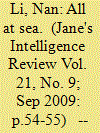

|
|
|
|
|
| Publication |
2009.
|
| Summary/Abstract |
When analysing China's naval development, international media naturally focus on the headline-grabbing platforms. The potential for an aircraft carrier and the Type 094 ballistic missile submarine garner the most attention.
|
|
|
|
|
|
|
|
|
|
|
|
|
|
|
|
| 2 |
ID:
110363
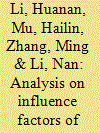

|
|
|
|
|
| Publication |
2011.
|
| Summary/Abstract |
With the intensification of global warming and continued growth in energy consumption, China is facing increasing pressure to cut its CO2 (carbon dioxide) emissions down. This paper discusses the driving forces influencing China's CO2 emissions based on Path-STIRPAT model-a method combining Path analysis with STIRPAT (stochastic impacts by regression on population, affluence and technology) model. The analysis shows that GDP per capita (A), industrial structure (IS), population (P), urbanization level (R) and technology level (T) are the main factors influencing China's CO2 emissions, which exert an influence interactively and collaboratively. The sequence of the size of factors' direct influence on China's CO2 emission is A>T>P>R>IS, while that of factors' total influence is A>R>P>T>IS. One percent increase in A, IS, P, R and T leads to 0.44, 1.58, 1.31, 1.12 and -1.09 percentage change in CO2 emission totally, where their direct contribution is 0.45, 0.07, 0.63, 0.08, 0.92, respectively. Improving T is the most important way for CO2 reduction in China.
|
|
|
|
|
|
|
|
|
|
|
|
|
|
|
|
| 3 |
ID:
108218
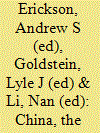

|
|
|
|
|
| Publication |
Maryland, Naval Institute Press, 2010.
|
| Description |
xxix, 529p.
|
| Standard Number |
9781591142430, hbk
|
|
|
|
|
|
|
|
|
|
|
|
Copies: C:1/I:0,R:0,Q:0
Circulation
| Accession# | Call# | Current Location | Status | Policy | Location |
| 056221 | 359.030951/ERI 056221 | Main | On Shelf | General | |
|
|
|
|
| 4 |
ID:
067191
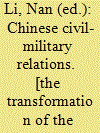

|
|
|
|
|
| Publication |
London, Routledge, 2005.
|
| Description |
xii, 212p.
|
| Series |
Asian security studies; 4
|
| Standard Number |
0415379326
|
|
|
|
|
|
|
|
|
|
|
|
Copies: C:1/I:0,R:0,Q:0
Circulation
| Accession# | Call# | Current Location | Status | Policy | Location |
| 050501 | 322.50951/LI 050501 | Main | On Shelf | General | |
|
|
|
|
| 5 |
ID:
089064
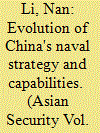

|
|
|
|
|
| Publication |
2009.
|
| Summary/Abstract |
This study first shows that China's naval strategy has undergone two major changes: from "near-coast defense" prior to the mid-1980s to "near-seas active defense" after the mid-1980s, and then to the advancement of a "far-seas operations" strategy. Related to the evolution of naval strategy is the change in naval capabilities: from limited capabilities for coastal defense to more expansive capabilities to operate more effectively in China's near seas by the late 2000s. The new strategy of "far-seas operations" endorsed since the mid-2000s may have major implications for the future development of China's naval capabilities. Second, this study argues that changes in naval strategy and capabilities can be accounted for by a combination of major variables, including the role of naval leadership and personal experience, endorsement of civilian leadership, changing perception of external security environment, availability of funding and technologies, and institutionalization of naval research. Also, while a major change in naval capabilities may be related to a change in naval strategy, it may also be driven by other highly contingent or idiosyncratic reasons.
|
|
|
|
|
|
|
|
|
|
|
|
|
|
|
|
|
|
|
|
|